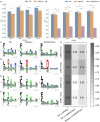Unbiased Characterization of Peptide-HLA Class II Interactions Based on Large-Scale Peptide Microarrays; Assessment of the Impact on HLA Class II Ligand and Epitope Prediction
- PMID: 32903714
- PMCID: PMC7438773
- DOI: 10.3389/fimmu.2020.01705
Unbiased Characterization of Peptide-HLA Class II Interactions Based on Large-Scale Peptide Microarrays; Assessment of the Impact on HLA Class II Ligand and Epitope Prediction
Abstract
Human Leukocyte Antigen class II (HLA-II) molecules present peptides to T lymphocytes and play an important role in adaptive immune responses. Characterizing the binding specificity of single HLA-II molecules has profound impacts for understanding cellular immunity, identifying the cause of autoimmune diseases, for immunotherapeutics, and vaccine development. Here, novel high-density peptide microarray technology combined with machine learning techniques were used to address this task at an unprecedented level of high-throughput. Microarrays with over 200,000 defined peptides were assayed with four exemplary HLA-II molecules. Machine learning was applied to mine the signals. The comparison of identified binding motifs, and power for predicting eluted ligands and CD4+ epitope datasets to that obtained using NetMHCIIpan-3.2, confirmed a high quality of the chip readout. These results suggest that the proposed microarray technology offers a novel and unique platform for large-scale unbiased interrogation of peptide binding preferences of HLA-II molecules.
Keywords: HLA; MHC class II; antigen presentation; high-throughput; machine learning; peptide binding; prediction; ultra-high density peptide microarray.
Copyright © 2020 Wendorff, Garcia Alvarez, Østerbye, ElAbd, Rosati, Degenhardt, Buus, Franke and Nielsen.
Figures


Similar articles
-
Determination of a Predictive Cleavage Motif for Eluted Major Histocompatibility Complex Class II Ligands.Front Immunol. 2018 Aug 6;9:1795. doi: 10.3389/fimmu.2018.01795. eCollection 2018. Front Immunol. 2018. PMID: 30127785 Free PMC article.
-
Improved peptide-MHC class II interaction prediction through integration of eluted ligand and peptide affinity data.Immunogenetics. 2019 Jul;71(7):445-454. doi: 10.1007/s00251-019-01122-z. Epub 2019 Jun 10. Immunogenetics. 2019. PMID: 31183519
-
Systematically benchmarking peptide-MHC binding predictors: From synthetic to naturally processed epitopes.PLoS Comput Biol. 2018 Nov 8;14(11):e1006457. doi: 10.1371/journal.pcbi.1006457. eCollection 2018 Nov. PLoS Comput Biol. 2018. PMID: 30408041 Free PMC article.
-
Mechanistic understanding and significance of small peptides interaction with MHC class II molecules for therapeutic applications.Immunol Rev. 2016 Jul;272(1):151-68. doi: 10.1111/imr.12435. Immunol Rev. 2016. PMID: 27319349 Review.
-
Evaluating the immunogenicity of protein drugs by applying in vitro MHC binding data and the immune epitope database and analysis resource.Clin Dev Immunol. 2013;2013:467852. doi: 10.1155/2013/467852. Epub 2013 Oct 8. Clin Dev Immunol. 2013. PMID: 24222776 Free PMC article. Review.
Cited by
-
Vaccines for immunoprevention of DNA mismatch repair deficient cancers.J Immunother Cancer. 2022 Jun;10(6):e004416. doi: 10.1136/jitc-2021-004416. J Immunother Cancer. 2022. PMID: 35732349 Free PMC article. Review.
-
HLA Class II Presentation Is Specifically Altered at Elevated Temperatures in the B-Lymphoblastic Cell Line JY.Mol Cell Proteomics. 2021;20:100089. doi: 10.1016/j.mcpro.2021.100089. Epub 2021 Apr 29. Mol Cell Proteomics. 2021. PMID: 33933681 Free PMC article.
-
Mass Spectrometry-Based Immunopeptidomics of Peptides Presented on Human Leukocyte Antigen Proteins.Methods Mol Biol. 2024;2758:425-443. doi: 10.1007/978-1-0716-3646-6_23. Methods Mol Biol. 2024. PMID: 38549028
References
Publication types
MeSH terms
Substances
LinkOut - more resources
Full Text Sources
Research Materials

